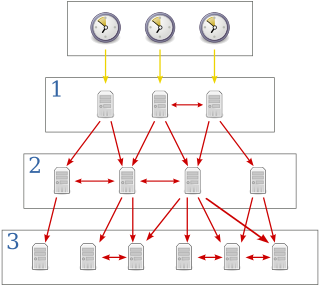Related Research Articles
The Dynamic Host Configuration Protocol (DHCP) is a network management protocol used on Internet Protocol (IP) networks for automatically assigning IP addresses and other communication parameters to devices connected to the network using a client–server architecture.

HTTP is an application layer protocol in the Internet protocol suite model for distributed, collaborative, hypermedia information systems. HTTP is the foundation of data communication for the World Wide Web, where hypertext documents include hyperlinks to other resources that the user can easily access, for example by a mouse click or by tapping the screen in a web browser.

Kerberos is a computer-network authentication protocol that works on the basis of tickets to allow nodes communicating over a non-secure network to prove their identity to one another in a secure manner. Its designers aimed it primarily at a client–server model, and it provides mutual authentication—both the user and the server verify each other's identity. Kerberos protocol messages are protected against eavesdropping and replay attacks.
Telnet is a client/server application protocol that provides access to virtual terminals of remote systems on local area networks or the Internet. It is a protocol for bidirectional 8-bit communications. Its main goal was to connect terminal devices and terminal-oriented processes.

The Network Time Protocol (NTP) is a networking protocol for clock synchronization between computer systems over packet-switched, variable-latency data networks. In operation since before 1985, NTP is one of the oldest Internet protocols in current use. NTP was designed by David L. Mills of the University of Delaware.
In computing, Internet Key Exchange is the protocol used to set up a security association (SA) in the IPsec protocol suite. IKE builds upon the Oakley protocol and ISAKMP. IKE uses X.509 certificates for authentication ‒ either pre-shared or distributed using DNS ‒ and a Diffie–Hellman key exchange to set up a shared session secret from which cryptographic keys are derived. In addition, a security policy for every peer which will connect must be manually maintained.
Zero-configuration networking (zeroconf) is a set of technologies that automatically creates a usable computer network based on the Internet Protocol Suite (TCP/IP) when computers or network peripherals are interconnected. It does not require manual operator intervention or special configuration servers. Without zeroconf, a network administrator must set up network services, such as Dynamic Host Configuration Protocol (DHCP) and Domain Name System (DNS), or configure each computer's network settings manually.
Datagram Transport Layer Security (DTLS) is a communications protocol providing security to datagram-based applications by allowing them to communicate in a way designed to prevent eavesdropping, tampering, or message forgery. The DTLS protocol is based on the stream-oriented Transport Layer Security (TLS) protocol and is intended to provide similar security guarantees. The DTLS protocol datagram preserves the semantics of the underlying transport—the application does not suffer from the delays associated with stream protocols, but because it uses User Datagram Protocol (UDP) or Stream Control Transmission Protocol (SCTP), the application has to deal with packet reordering, loss of datagram and data larger than the size of a datagram network packet. Because DTLS uses UDP or SCTP rather than TCP it avoids the TCP meltdown problem when being used to create a VPN tunnel.
In computing, syslog is a standard for message logging. It allows separation of the software that generates messages, the system that stores them, and the software that reports and analyzes them. Each message is labeled with a facility code, indicating the type of system generating the message, and is assigned a severity level.
The Line Printer Daemon protocol/Line Printer Remote protocol is a network printing protocol for submitting print jobs to a remote printer. The original implementation of LPD was in the Berkeley printing system in the BSD UNIX operating system; the LPRng project also supports that protocol. The Common Unix Printing System, which is more common on modern Linux distributions and also found on macOS, supports LPD as well as the Internet Printing Protocol (IPP). Commercial solutions are available that also use Berkeley printing protocol components, where more robust functionality and performance is necessary than is available from LPR/LPD alone. The LPD Protocol Specification is documented in RFC 1179.

The Printer Working Group (PWG) is a Program of the IEEE Industry Standard and Technology Organization (ISTO) with members including printer and multi-function device manufacturers, print server developers, operating system providers, print management application developers, and industry experts. Originally founded in 1991 as the Network Printing Alliance, the PWG is chartered to make printers, multi-function devices, and the applications and operating systems supporting them work together better.
In computing, a shared resource, or network share, is a computer resource made available from one host to other hosts on a computer network. It is a device or piece of information on a computer that can be remotely accessed from another computer transparently as if it were a resource in the local machine. Network sharing is made possible by inter-process communication over the network.
An IPv6 transition mechanism is a technology that facilitates the transitioning of the Internet from the Internet Protocol version 4 (IPv4) infrastructure in use since 1983 to the successor addressing and routing system of Internet Protocol Version 6 (IPv6). As IPv4 and IPv6 networks are not directly interoperable, transition technologies are designed to permit hosts on either network type to communicate with any other host.

WebSocket is a computer communications protocol, providing a simultaneous two-way communication channel over a single Transmission Control Protocol (TCP) connection. The WebSocket protocol was standardized by the IETF as RFC 6455 in 2011. The current specification allowing web applications to use this protocol is known as WebSockets. It is a living standard maintained by the WHATWG and a successor to The WebSocket API from the W3C.
A mailbox provider, mail service provider or, somewhat improperly, email service provider is a provider of email hosting. It implements email servers to send, receive, accept, and store email for other organizations or end users, on their behalf.
Token Binding is a proposed standard for a Transport Layer Security (TLS) extension that aims to increase TLS security by using cryptographic certificates on both ends of the TLS connection. Current practice often depends on bearer tokens, which may be lost or stolen. Bearer tokens are also vulnerable to man-in-the-middle attacks or replay attacks. In contrast, bound tokens are established by a user agent that generates a private-public key pair per target server, providing the public key to the server, and thereafter proving possession of the corresponding private key on every TLS connection to the server.
HTTP/3 is the third major version of the Hypertext Transfer Protocol used to exchange information on the World Wide Web, complementing the widely-deployed HTTP/1.1 and HTTP/2. Unlike previous versions which relied on the well-established TCP, HTTP/3 uses QUIC, a multiplexed transport protocol built on UDP.
The JSON Meta Application Protocol (JMAP) is a set of related open Internet Standard protocols for handling email. JMAP is implemented using JSON APIs over HTTP and has been developed as an alternative to IMAP/SMTP and proprietary email APIs such as Google's Gmail and Microsoft's MAPI . Additional protocols and data models being built on top of the core of JMAP for handling contacts and calendar synchronization are meant to be potential replacements for CardDAV and CalDAV, and other support is currently in the works.
References
- ↑ "IPP Everywhere" . Retrieved April 2, 2019.
- ↑ Michael Sweet, Apple Inc. (May 15, 2018). "CUPS Plenary, Joint PWG/Open Printing Meeting, Sunnyvale, California" (PDF). Printer Working Group . Retrieved April 2, 2019.
- ↑ "IPP", Working groups, IETF.
- ↑ Internet Printing Protocol/1.0: Encoding and Transport. doi: 10.17487/RFC2565 . RFC 2565.
- ↑ Internet Printing Protocol/1.0: Model and Semantics. doi: 10.17487/RFC2566 . RFC 2566.
- ↑ Design Goals for an Internet Printing Protocol. doi: 10.17487/RFC2567 . RFC 2567.
- ↑ Rationale for the Structure of the Model and Protocol for the Internet Printing Protocol. doi: 10.17487/RFC2568 . RFC 2568.
- ↑ Mapping between LPD and IPP Protocols. doi: 10.17487/RFC2569 . RFC 2569.
- ↑ Internet Printing Protocol/1.0: Implementer's Guide. doi: 10.17487/RFC2639 . RFC 2639.
- ↑ Internet Printing Protocol/1.1: Encoding and Transport. doi: 10.17487/RFC2910 . RFC 2910.
- ↑ Internet Printing Protocol/1.1: Model and Semantics. doi: 10.17487/RFC2911 . RFC 2911.
- ↑ Internet Printing Protocol/1.1: Implementor's Guide. doi: 10.17487/RFC3196 . RFC 3196.
- ↑ Internet Printing Protocol/1.1: IPP URL Scheme. doi: 10.17487/RFC3510 . RFC 3510.
- ↑ Internet Printing Protocol (IPP) over HTTPS Transport Binding and the 'ipps' URI Scheme. doi: 10.17487/RFC7472 . RFC 7472.
- ↑ RFC 8010. doi: 10.17487/RFC8010 .
- ↑ Internet Printing Protocol/1.1: Model and Semantics. doi: 10.17487/RFC8011 . RFC 8011.
- ↑ Internet Printing Protocol/1.1. STD 92.
- ↑ PWG 5100.10-2009 (PDF), PWG.
- ↑ PWG 5100.12-2011 (PDF), PWG.
- ↑ PWG 5100.12-2015 (PDF), PWG.
- ↑ Upgrading to TLS Within HTTP/1.1, IETF, RFC 2817
- ↑ "CUPSDriverlessPrinting". Debian Wiki. Archived from the original on 2021-10-31. Retrieved 2021-12-13.
- ↑ "Universal Print from Microsoft". Microsoft. Retrieved 2023-05-18.
- ↑ "Internet Printing Protocol". Printer Working Group. Archived from the original on 2010-01-12. Retrieved 2013-11-20. The language "CUPS Software (IPP Reference Implementation)" appeared on this page since a point between 1 September 2009 and 12 January 2010, though no mention of a reference implementation is found in the published standard.
- ↑ "Effectively Using IPP Printing". Microsoft. April 8, 2003. Retrieved 2009-09-06.
- ↑ "The Internet Printing Client (IPP) is not available in Windows 7 Starter Edition". Microsoft. November 17, 2010. Retrieved 2012-10-02.